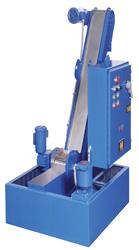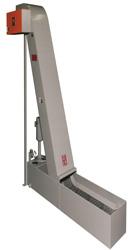- FMA
- The Fabricator
- FABTECH
- Canadian Metalworking
Categories
- Additive Manufacturing
- Aluminum Welding
- Arc Welding
- Assembly and Joining
- Automation and Robotics
- Bending and Forming
- Consumables
- Cutting and Weld Prep
- Electric Vehicles
- En Español
- Finishing
- Hydroforming
- Laser Cutting
- Laser Welding
- Machining
- Manufacturing Software
- Materials Handling
- Metals/Materials
- Oxyfuel Cutting
- Plasma Cutting
- Power Tools
- Punching and Other Holemaking
- Roll Forming
- Safety
- Sawing
- Shearing
- Shop Management
- Testing and Measuring
- Tube and Pipe Fabrication
- Tube and Pipe Production
- Waterjet Cutting
Industry Directory
Webcasts
Podcasts
FAB 40
Advertise
Subscribe
Account Login
Search
Moving material efficiently
4 questions to ask before purchasing a conveying system
- By John Mackowski
- November 7, 2006
- Article
- Materials Handling
Material handling from stamping operations can present unique challenges. Regardless of whether you're handling scrap or finished parts, you need to think about several points to select the right equipment for your particular application.
You have many equipment choices today to move, elevate, and distribute material. If you're considering a belt, vibratory, or a magnetic conveyor, ask the following four questions before you buy one.
1. What material is being handled?
Stamping presses form many materials, such as aluminum, stainless steel, steel, and other alloys.
Both steel-belt and cloth-belt conveyors can handle almost any part; however, if the material has sharp edges, the likelihood of a cloth belt being cut is increased. Additionally, sharp parts may have small, slender points that can get caught in the hinges of a hinged-belt conveyor. While belt conveyors are versatile in the types of material they can handle, cut belts and conveyor jams have the potential to cause a significant amount of downtime.
Vibratory conveyors also can handle nearly all materials. With this style of conveying system, material rides in pans or trays, which are not likely to be damaged by sharp edges. These units do not have any hinges that can catch sharp points. They do, however, require more space than belt conveyors and move materials on a 3- to 5-degree incline or a 0- to 15-degree decline.
If the only material being handled is steel, a magnetic conveyor also is an option. Unlike a belt conveyor, a magnetic conveyor has no external moving parts that material can get jammed in. Furthermore, a magnetic conveyor is completely sealed, so the chance of parts or scrap getting inside and jamming the actual conveyor mechanism is eliminated.
On magnetic conveyors, the material slides along a stainless steel slider bed similar to a vibratory conveyor and can control material movement from a 90-degree decline to a 90-degree incline (see Figure 1). A drawback of magnetic conveyors is that they can move only material with a magnetic force.
2. How much lubrication is present on the material?
Most stamped parts require some type of lubricant on the material. The type of lubricant, as well as the amount used, creates concerns for all kinds of equipment.
With a belt conveyor, lubricant can cause the material to adhere to the belt and may also cause the belt to slip on its pulleys. Additionally, material that sticks to the belt may be carried inside the conveyor housing and eventually trigger a jam. Keep in mind that these same issues may also affect a hinged steel-belt conveyor. Dimpled surfaces on hinged steel-belt conveyors and rough-top belts may help deter parts from sticking.
Lubricants also can affect vibratory conveying equipment. Lubricant tends to make the parts stick to the pan or tray, causing a buildup. If a substantial amount or lubricant is present, it may build up in the tray and form a pool. To help reduce the surface area that wet parts come in contact with and decrease the chance of parts sticking, some manufacturers offer rigidized material trays. Screen decks or perforated trays also allow coolants and lubricants to drain from material being conveyed.

Figure 1On a magnetic conveying system, material slides along a stainless steel slider bed similar to a vibratory conveyor, but there is no chance of belt damage.
When moving wet materials, magnetic conveyors may be susceptible to the same problems as vibratory conveyors are. Like vibratory conveyors, the slider surface on magnetic conveyors can be manufactured from a rigidized material to reduce adhesion. Drains also can be added to remove excess lubricant from the conveying surface. Remember, the thinner the material being conveyed, the more likely it is that adhesion will occur. Materials thicker than 11 gauge do not require rigidized slider surfaces.
3. What is the material's shape and size?
Material size and shape is not much of a concern with belt-style conveyors, as belt width can be increased to handle whatever is being presented (see Figure 2). Because the material rides on top of the belt, it typically doesn't make a difference if the material overlaps. Hinged steel-belt conveyors can be designed with flights spaced to accommodate the material size.
If you are considering vibratory equipment, let the manufacturer know the size of the material as well as the weight. Larger, irregular-shaped pieces have less surface contact with the tray and slow feed rates. In addition, tray width needs to be at least 50 percent wider than the longest dimension of the material fed.
Size and shape are very important with magnetic conveyors. Material that is large enough to contact more than one of the magnetic elements may cause magnetic bridging, in which the material spans two magnets and can either move along with the leading magnet or stay back with the trailing magnet. The result is the conveyor will not move the material at all. If magnetic bridging occurs, magnet spacing may have to be adjusted, which could decrease capacity
4. How is the material presented to the conveyor?
Material dropped onto any conveyor can cause damage. If the material has sharp edges or corners, it could damage belt-style conveyors. Parts dropped in a pan or tray of a vibratory conveyor also can cause damage, including dents in the conveying surface.
Magnetic conveying systems are most susceptible to damage from dropped material. Because all the moving parts are inside the conveyor housing, a dent in the housing may cause the magnets to strike the back side of the slider, creating premature slider bed wear as well as damage to each magnetic element. If material is falling as much as 12 inches to the slider bed, an impact plate or diverters can be installed to absorb the impact before the material hits the slider bed.
Making the Right Choice
It's a challenge to select the most efficient conveyor for a particular application. To make the best choice, it's imperative that you consider all operating parameters. Be prepared that the conveyor system you choose will need to be designed or modified to meet your specific material handling requirements. Some conveyor manufacturers offer test facilities where materials and processes can be tested to determine the right equipment solution.
About the Author
John Mackowski
Eriez Magnetics
Related Companies
subscribe now

The Fabricator is North America's leading magazine for the metal forming and fabricating industry. The magazine delivers the news, technical articles, and case histories that enable fabricators to do their jobs more efficiently. The Fabricator has served the industry since 1970.
start your free subscription- Stay connected from anywhere

Easily access valuable industry resources now with full access to the digital edition of The Fabricator.

Easily access valuable industry resources now with full access to the digital edition of The Welder.

Easily access valuable industry resources now with full access to the digital edition of The Tube and Pipe Journal.
- Podcasting
- Podcast:
- The Fabricator Podcast
- Published:
- 04/16/2024
- Running Time:
- 63:29
In this episode of The Fabricator Podcast, Caleb Chamberlain, co-founder and CEO of OSH Cut, discusses his company’s...
- Industry Events
16th Annual Safety Conference
- April 30 - May 1, 2024
- Elgin,
Pipe and Tube Conference
- May 21 - 22, 2024
- Omaha, NE
World-Class Roll Forming Workshop
- June 5 - 6, 2024
- Louisville, KY
Advanced Laser Application Workshop
- June 25 - 27, 2024
- Novi, MI

































